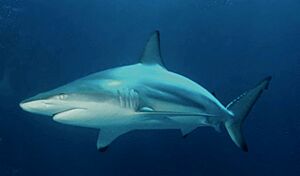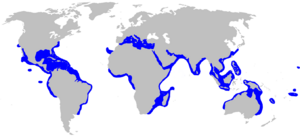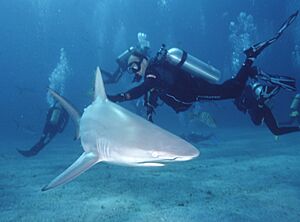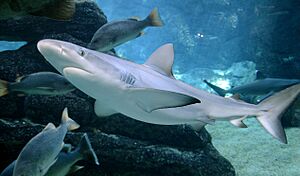Blacktip shark facts for kids
Quick facts for kids Blacktip shark |
|
|---|---|
 |
|
| Conservation status | |
| Scientific classification | |
| Genus: |
Carcharhinus
|
| Species: |
limbatus
|
 |
|
| Range of the blacktip shark | |
| Synonyms | |
|
|
The blacktip shark (Carcharhinus limbatus) is a type of requiem shark. It belongs to the Carcharhinidae family. You can find these sharks in warm coastal waters all over the world. They even live in brackish water, which is a mix of fresh and salt water.
Blacktip sharks have strong, torpedo-shaped bodies with pointed snouts. They have long gill slits and no ridge between their two dorsal fins. Most of them have black tips or edges on their pectoral, dorsal, pelvic, and caudal fins. They usually grow to about 1.5 m (4.9 ft) long.
These sharks are fast and active hunters that mostly eat fish. They are famous for leaping and spinning out of the water when they attack schools of small fish. Blacktip sharks are often described as "shy" compared to other large sharks. Young and adult blacktip sharks often swim together in groups. Like other sharks in their family, females give birth to live pups. They have one to 10 pups every two years. Young sharks grow up in shallow nursery areas. Adult females often return to the same nurseries where they were born to have their own babies. Sometimes, female blacktip sharks can even have babies without a male, which is called asexual reproduction.
Blacktip sharks are usually careful around humans. But they can become aggressive if there is food nearby. They have been involved in some shark incidents with people. This shark is important for both commercial and recreational fishing. People use its meat, skin, fins, and liver oil. The IUCN lists the blacktip shark as Vulnerable. This is because they don't have many babies, and they are often caught by fishers.
Contents
Meet the Blacktip Shark: What's in a Name?
The blacktip shark was first described in 1839. A French scientist named Achille Valenciennes gave it the name Carcharias (Prionodon) limbatus. Later, scientists moved it to the group of sharks called Carcharhinus. The name limbatus comes from Latin and means "bordered." This refers to the black edges on the shark's fins. People also call this shark by other names, like blackfin shark or spotfin ground shark.
Shark Family Tree: How Blacktip Sharks Are Related
Scientists used to think the blacktip shark was closely related to the graceful shark and the spinner shark. This was because they looked and acted alike. But studies of their DNA show different results. These studies suggest the blacktip shark might be closer to the blacknose shark. More research is needed to fully understand how blacktip sharks are related to other Carcharhinus species.
DNA studies have also shown that there are two main groups of blacktip sharks. One group lives in the western Atlantic Ocean. The other group lives in the eastern Atlantic, Indian, and Pacific Oceans. This suggests that the sharks in the Indo-Pacific came from the eastern Atlantic. The western Atlantic sharks became separated as the Atlantic Ocean grew wider. They also became separated by the formation of the Isthmus of Panama. Blacktip sharks from these two regions look different and have different life habits. The eastern Atlantic group might even be a separate species. Scientists have found fossil teeth from blacktip sharks in places like Delaware and Florida. These teeth are from about 23 to 16 million years ago.
What Does a Blacktip Shark Look Like?
The blacktip shark has a strong, smooth body. It has a long, pointed snout and fairly small eyes. Its five pairs of gill slits are longer than those of similar sharks. Inside its jaws, it has 15 rows of teeth on each side. The teeth are wide at the bottom with a tall, narrow point and jagged edges.
The first dorsal fin is tall and curved like a sickle. There is no ridge between the first and second dorsal fins. The large pectoral fins are also curved and pointed.
These sharks are gray to brown on top and white underneath. They have a clear white stripe running along their sides. Their pectoral fins, second dorsal fin, and the lower part of their caudal fin usually have black tips. Sometimes, their pelvic fins and anal fin also have black tips. The first dorsal fin and the upper part of the caudal fin usually have black edges. Some older sharks might have fins with no black marks at all. Blacktip sharks can temporarily lose most of their color during algal blooms. This happens when tiny ocean plants called coccolithophores multiply a lot. The largest blacktip shark found was 2.8 m (9.2 ft) long. However, 1.5 m (4.9 ft) is more common. The heaviest known blacktip shark weighed 123 kg (271 lb).
Where Do Blacktip Sharks Live?
Blacktip sharks live all over the world in warm, tropical, and subtropical waters. In the Atlantic Ocean, you can find them from Massachusetts down to Brazil. This includes the Gulf of Mexico and the Caribbean Sea. They also live from the Mediterranean Sea to the Democratic Republic of the Congo.
Around the Indian Ocean, they are found from South Africa to Southeast Asia. This includes places like the Arabian Peninsula and India. In the western Pacific, they live from Japan to northern Australia. This area includes southern China, the Philippines, and Indonesia. In the eastern Pacific, they are found from Southern California to Peru. They have also been seen near many Pacific islands, like Hawaii and the Galápagos.
Most blacktip sharks live in water less than 30 m (98 ft) deep. They prefer areas over continental and island shelves. However, they can dive down to 64 m (210 ft). They like muddy bays, island lagoons, and areas near coral reefs. They can also live in water with low salinity, like estuaries and mangrove swamps. Even though you might find one far from shore, blacktip sharks do not live in the open ocean. Sharks off the east coast of the United States move north in the summer and south to Florida in the winter. This is a type of seasonal migration.
Blacktip Shark Behavior and Ecology
The blacktip shark is a very fast and active predator. They are usually found in groups of different sizes. Males, non-pregnant females, and pregnant females tend to stay in separate groups. Young sharks also stay apart from adults. In Terra Ceia Bay, Florida, which is a nursery area, young blacktips gather during the day. They spread out at night. They gather most strongly in early summer when they are youngest. This suggests they group together for safety from bigger predators, mostly larger sharks. Avoiding predators might also be why young blacktips don't gather in areas with the most food. Adult blacktip sharks do not have any known predators.
Blacktip sharks can have small creatures called parasites living on them. These include tiny crustaceans called copepods and flatworms called monogeneans. These parasites attach to the shark's skin. This species can also have nematodes, which are a type of worm, in their ovaries.
Amazing Jumps and Social Life
Like the spinner shark, the blacktip shark is known for leaping out of the water. They can spin three or four times in the air before landing! Some of these jumps happen after they've been chasing fish. The shark swims up through a school of fish in a spiral. Its speed then launches it into the air. People have also seen blacktip sharks jump out of the water in the Bahamas. They might do this to shake off sharksuckers. These fish attach to the shark's skin and can be irritating. The shark can reach speeds of about 6.3 meters per second (21 feet per second) during these jumps.
Blacktip sharks are generally shy. They often back down from Galapagos sharks and silvertip sharks of the same size when competing for food. If they feel threatened, they might do a special "threat display." The shark swims towards what's bothering it, then turns away. It rolls from side to side, lowers its pectoral fins, tilts its head and tail up, and makes sideways biting movements. This whole display lasts about 25 seconds. This behavior is similar to how a shark tries to get rid of a sharksucker.
What Do Blacktip Sharks Eat?
Fish make up about 90% of the blacktip shark's diet. They eat many different kinds of fish. These include sardines, herring, anchovies, mullet, mackerel, and groupers. They also eat rays and skates. Sometimes, they will eat smaller sharks like smoothhounds. Occasionally, they eat Crustaceans (like crabs) and cephalopods (like squid). In the Gulf of Mexico, their favorite food is the Gulf menhaden. Off South Africa, they mostly eat jacks and herring. They hunt most actively at dawn and dusk. Blacktip sharks can get very excited and social when there's a lot of food around. This can lead to feeding frenzies. This happens, for example, when fishing boats throw their waste overboard.
Blacktip Shark Life Cycle and Reproduction
Like other requiem sharks, blacktip sharks give birth to live young. Females usually have four to seven pups, but sometimes up to 10. They have babies every two years. They use shallow coastal areas as nurseries. These nurseries have lots of food and fewer predators. Some known nurseries are in Florida and Brazil. Adult blacktip sharks travel long distances. But they usually return to the same nursery areas where they were born to give birth. This means there are different groups of sharks that breed in specific places.
Mating happens from spring to early summer. The pups are born around the same time the next year. The pregnancy lasts for 10 to 12 months. Female sharks have one working ovary and two working uteruses. Each uterus has separate sections, with one baby shark in each. The baby sharks first get food from a yolk sac. After about 10 or 11 weeks, the yolk runs out. Then, the yolk sac changes into a special connection called a placenta. This placenta feeds the baby shark until it is born. Pups are born about 55–60 cm (22–24 in) long off the eastern United States. They are 61–65 cm (24–26 in) long off North Africa. Many young sharks, about 61-91%, die in their first 15 months. The main dangers are being eaten or starving. Young sharks stay in the nurseries until their first autumn. Then, they move to warmer places for the winter.
Blacktip sharks grow slower as they get older. They grow 25–30 cm (9.8–11.8 in) in the first six months. Then, they grow 20 cm (7.9 in) a year until their second year. After that, they grow 10 cm (3.9 in) a year until they are adults. Adult sharks grow about 5 cm (2.0 in) a year. The size at which they become adults changes depending on where they live. Males become adults at about 1.3–1.5 m (4.3–4.9 ft). Females become adults at about 1.5–1.8 m (4.9–5.9 ft). Males are ready to have babies at 4-5 years old. Females are ready at 7-8 years old. They can live for at least 12 years.
In 2007, a 9-year-old female blacktip shark at the Virginia Aquarium became pregnant. She had a single baby female pup. What was amazing is that she had never been with a male shark! DNA tests showed that her baby was born through parthenogenesis. This is a type of asexual reproduction. It means an egg cell combines with another cell from the mother to form a baby without a father. This event, along with a similar case in the bonnethead shark, suggests that asexual reproduction might be more common in sharks than scientists thought.
Blacktip Sharks and People
Blacktip sharks have been known to be curious about divers. But they usually stay a safe distance away. Most of the time, these shy sharks are not considered very dangerous to humans. However, they can become aggressive if food is around. Their size and speed mean people should still be careful. As of 2008, there have been 28 unprovoked incidents and 13 provoked incidents involving this species. Most of these incidents result in only minor injuries. Blacktip sharks are responsible for about 16% of shark incidents around Florida each year.
Blacktip sharks are one of the more common large sharks in coastal waters. Many are caught by fishers around the world. They are caught using longlines, nets, and hooks. Their meat is good quality and sold fresh, frozen, or dried and salted. Their fins are used for shark fin soup. Their skin is used for leather. Their liver oil is used for vitamins. The rest of the shark can be used for fishmeal. Blacktip sharks are very important to the shark fishing industry in the northwestern Atlantic. They are second only to the sandbar shark. The meat of the blacktip shark is thought to be better than the sandbar shark's. Because of this, sandbar sharks are sometimes sold as "blacktip shark" in the United States. Blacktip sharks are also very important to fisheries in India and Mexico. They are also caught in the Mediterranean and South China Seas, and off northern Australia.
The blacktip shark is popular with people who fish for fun in Florida, the Caribbean, and South Africa. It is listed as a game fish. Once hooked, this shark fights hard and sometimes jumps out of the water. Since 1995, the number of blacktip sharks caught by recreational anglers in the United States has been similar to or even more than those caught by commercial fishers.
The International Union for Conservation of Nature has listed the blacktip shark as Vulnerable. This means it is at risk because it doesn't have many babies. This makes it easy to catch too many of them. The United States and Australia are the only two countries that manage fishing for blacktip sharks. They do this under larger plans for many shark species. There are no special plans just for the blacktip shark's protection.
See also









